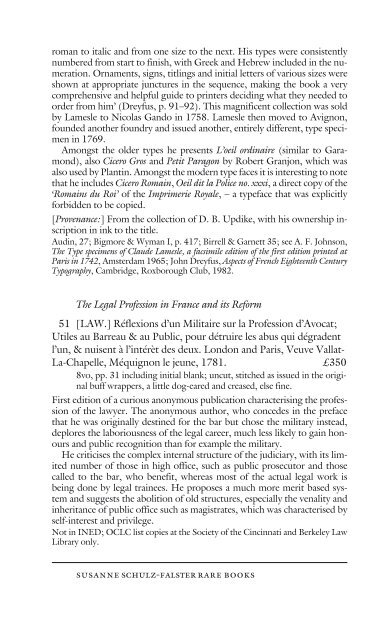Susanne Schulz-Falster Catalogue Fifteen
Susanne Schulz-Falster Catalogue Fifteen
Susanne Schulz-Falster Catalogue Fifteen
Create successful ePaper yourself
Turn your PDF publications into a flip-book with our unique Google optimized e-Paper software.
oman to italic and from one size to the next. His types were consistently<br />
numbered from start to finish, with Greek and Hebrew included in the numeration.<br />
Ornaments, signs, titlings and initial letters of various sizes were<br />
shown at appropriate junctures in the sequence, making the book a very<br />
comprehensive and helpful guide to printers deciding what they needed to<br />
order from him’ (Dreyfus, p. 91–92). This magnificent collection was sold<br />
by Lamesle to Nicolas Gando in 1758. Lamesle then moved to Avignon,<br />
founded another foundry and issued another, entirely different, type specimen<br />
in 1769.<br />
Amongst the older types he presents L’oeil ordinaire (similar to Garamond),<br />
also Cicero Gros and Petit Paragon by Robert Granjon, which was<br />
also used by Plantin. Amongst the modern type faces it is interesting to note<br />
that he includes Cicero Romain, Oeil dit la Police no. xxxi, a direct copy of the<br />
‘Romains du Roi’ of the Imprimerie Royale, – a typeface that was explicitly<br />
forbidden to be copied.<br />
[Provenance:] From the collection of D. B. Updike, with his ownership inscription<br />
in ink to the title.<br />
Audin, 27; Bigmore & Wyman I, p. 417; Birrell & Garnett 35; see A. F. Johnson,<br />
The Type specimens of Claude Lamesle, a facsimile edition of the first edition printed at<br />
Paris in 1742, Amsterdam 1965; John Dreyfus, Aspects of French Eighteenth Century<br />
Typography, Cambridge, Roxborough Club, 1982.<br />
The Legal Profession in France and its Reform<br />
51 [LAW.] Réflexions d’un Militaire sur la Profession d’Avocat;<br />
Utiles au Barreau & au Public, pour détruire les abus qui dégradent<br />
l’un, & nuisent à l’intérèt des deux. London and Paris, Veuve Vallat-<br />
La-Chapelle, Méquignon le jeune, 1781. £350<br />
8vo, pp. 31 including initial blank; uncut, stitched as issued in the original<br />
buff wrappers, a little dog-eared and creased, else fine.<br />
First edition of a curious anonymous publication characterising the profession<br />
of the lawyer. The anonymous author, who concedes in the preface<br />
that he was originally destined for the bar but chose the military instead,<br />
deplores the laboriousness of the legal career, much less likely to gain honours<br />
and public recognition than for example the military.<br />
He criticises the complex internal structure of the judiciary, with its limited<br />
number of those in high office, such as public prosecutor and those<br />
called to the bar, who benefit, whereas most of the actual legal work is<br />
being done by legal trainees. He proposes a much more merit based system<br />
and suggests the abolition of old structures, especially the venality and<br />
inheritance of public office such as magistrates, which was characterised by<br />
self-interest and privilege.<br />
Not in INED; OCLC list copies at the Society of the Cincinnati and Berkeley Law<br />
Library only.<br />
susanne schulz-falster rare books

















